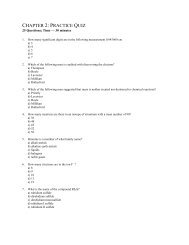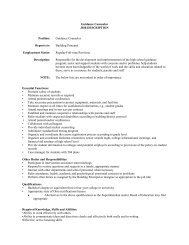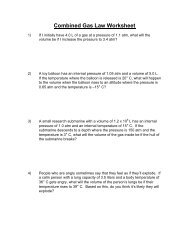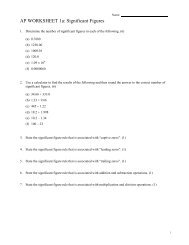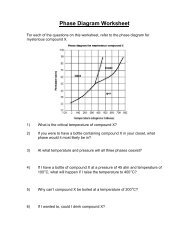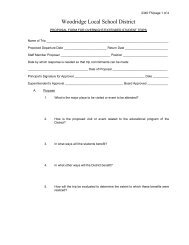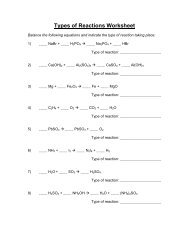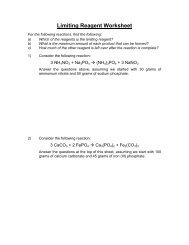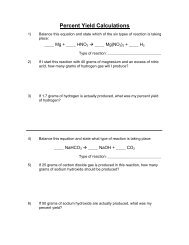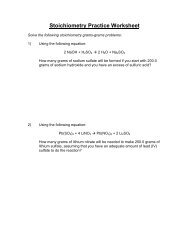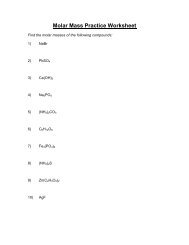Solutions Worksheet
Solutions Worksheet
Solutions Worksheet
You also want an ePaper? Increase the reach of your titles
YUMPU automatically turns print PDFs into web optimized ePapers that Google loves.
<strong>Solutions</strong> <strong>Worksheet</strong><br />
1) Why does water have such a low vapor pressure Explain.<br />
2) Give one example of surface tension you’re familiar with, and one<br />
example of a surfactant around your house.<br />
3) Why is ice less dense than water<br />
4) What’s the difference between a solution, a suspension, and a colloid<br />
Give examples of each.<br />
5) What does “like dissolve like” mean<br />
6) Why don’t oil and vinegar mix You should discuss this in terms of what<br />
happens at a molecular level.
7) Indicate the solvent that will be best at dissolving the given solute in each<br />
of the following problems:<br />
a) Solute: lithium acetate. Solvents: carbon disulfide, CH 2 Cl 2<br />
b) Solute: boron trichloride. Solvents: carbon tetrachloride, water.<br />
c) Solute: phosphorus triiodide. Solvents: ammonia, water.<br />
8) Explain which process would occur most quickly, a polar solvent<br />
dissolving a polar solute or a nonpolar solvent dissolving a nonpolar<br />
solute.
<strong>Solutions</strong> <strong>Worksheet</strong><br />
1) Why does water have such a low vapor pressure Explain.<br />
The hydrogen bonds in water are strong enough that they keep molecules<br />
from leaving the surface of the liquid and entering the vapor phase.<br />
2) Give one example of surface tension you’re familiar with, and one example of a<br />
surfactant around your house.<br />
There are lots and lots of examples of surface tension. Dishwashing<br />
detergent is a good surfactant.<br />
3) Why is ice less dense than water<br />
The hydrogen bonding in ice makes the structure more “open” than in<br />
liquid water. The extra spaces between molecules makes solid ice less<br />
dense than liquid water, so it floats.<br />
4) What’s the difference between a solution, a suspension, and a colloid Give<br />
examples of each.<br />
Solution: When one thing dissolves in each other – a homogeneous<br />
mixture (salt water, etc). Colloid: When very small particles of one thing<br />
are suspended in another in a stable fashion (milk, etc). Suspension:<br />
When larger particles of one thing are suspended in another and eventually<br />
settle out (ketchup, peanut butter).<br />
5) What does “like dissolve like” mean<br />
Solvents tend to dissolve solutes with similar polarities. For example,<br />
polar solvents dissolve polar solutes and nonpolar solvents dissolve<br />
nonpolar solutes.<br />
6) Why don’t oil and vinegar mix You should discuss this in terms of what<br />
happens at a molecular level.<br />
Oil is nonpolar and vinegar is polar. Take a look at the whole idea of “like<br />
dissolves like” for a better explanation of this.<br />
7) Indicate the solvent that will be best at dissolving the given solute in each of the<br />
following problems:<br />
a) Solute: lithium acetate. Solvents: carbon disulfide, CH 2 Cl 2<br />
b) Solute: boron trichloride. Solvents: carbon tetrachloride, water<br />
c) Solute: phosphorus triiodide. Solvents: ammonia, water.<br />
8) Explain which process would occur most quickly, a polar solvent dissolving a<br />
polar solute or a nonpolar solvent dissolving a nonpolar solute.<br />
Polar solvent dissolving a polar solute, because it’s a fairly active process<br />
as opposed to the passive “falling apart” of a nonpolar solute in a nonpolar<br />
solvent.



